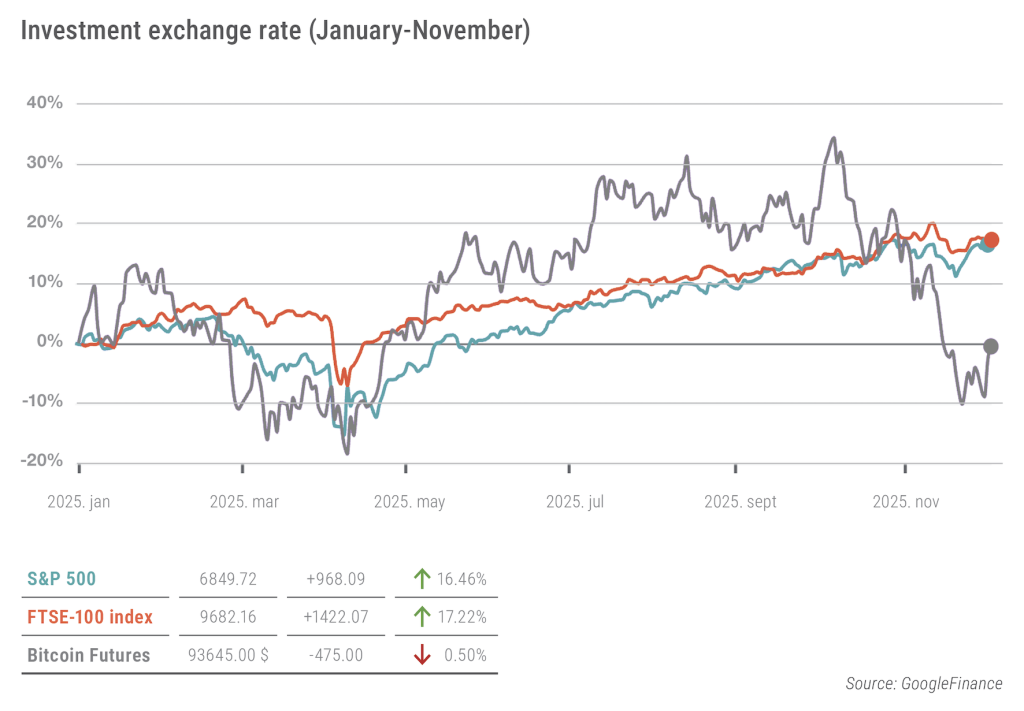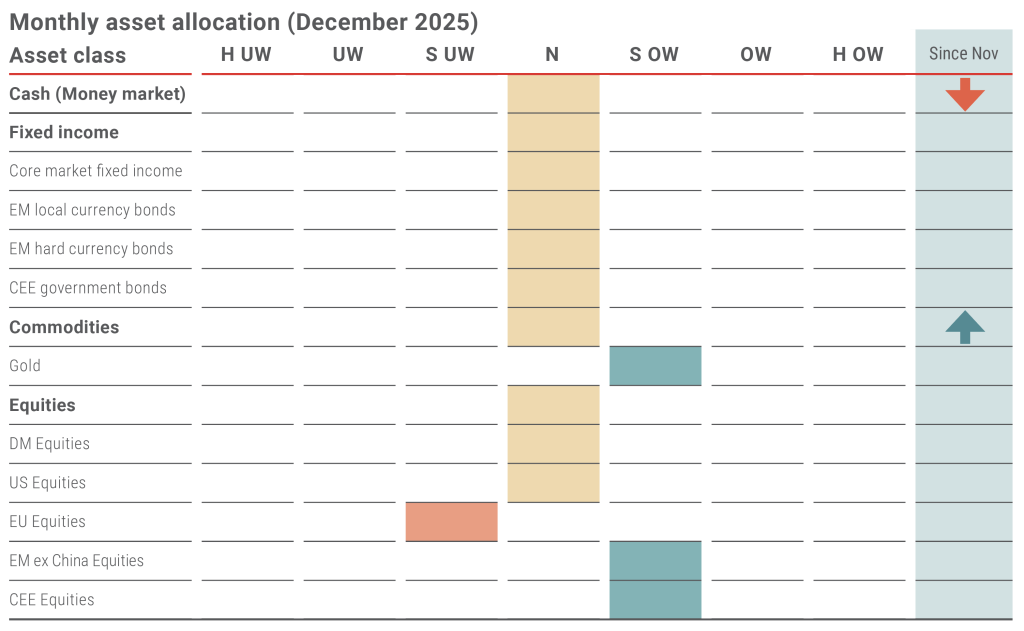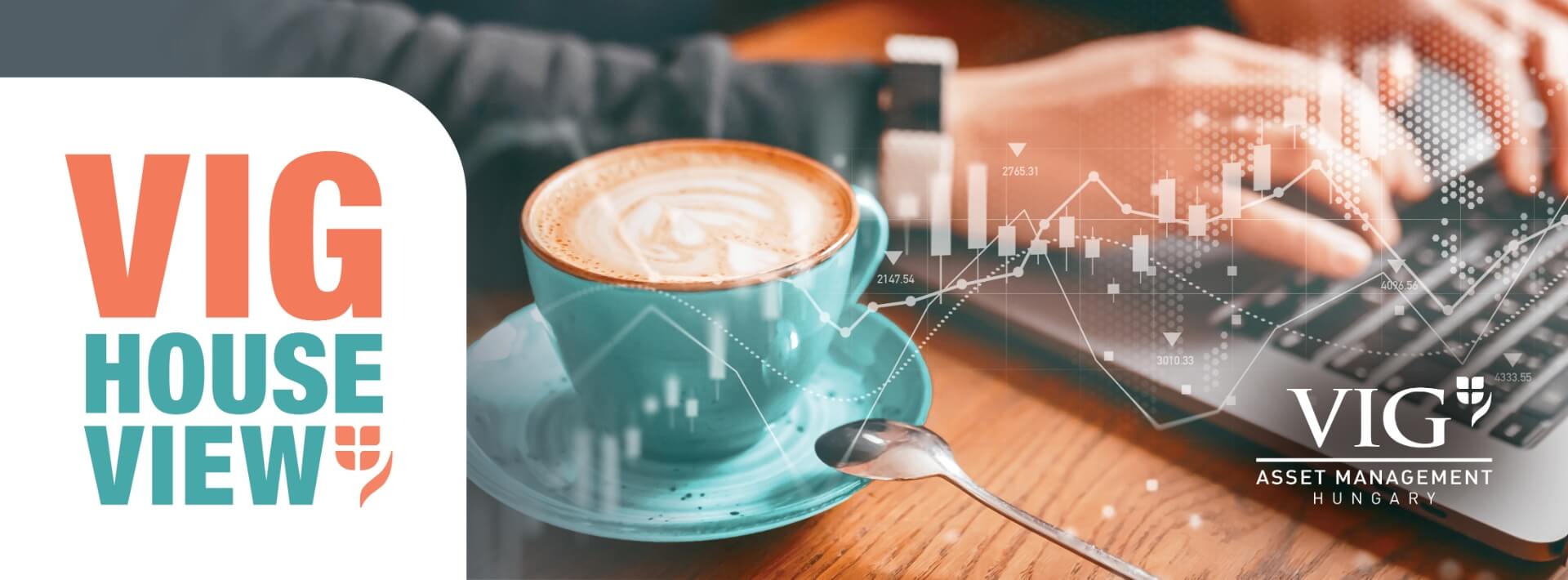What happened in the last month?
In focus: market correction and restart
A wave of global profit-taking swept through international equity markets at the end of November. In the final days of the month, several major indices – including the Dow Jones and the S&P 500 – reversed course after a prolonged period of gains, as investors closed positions and rotated significantly into safer assets such as gold and silver.
Concerns over a potential “AI bubble” bursting triggered the most visible sell-off in the technology sector. An increasing number of investors fear that the current, exceptionally high AI-related valuations may not be sustainable. The sector’s inherent risk sensitivity also spilled over into crypto markets, where Bitcoin and Ethereum both experienced steep corrections.
European equities were not spared either. The FTSE 100 in London recorded its sharpest drop since April, with the UK market proving particularly vulnerable to uncertainty surrounding AI-sector valuations. Cautious earnings expectations among US and European industrial companies further reinforced investor risk aversion, pushing even traditionally defensive sectors – including defence – into a declining trend.
By early December, however, risk appetite appeared to be returning. Weaker-than-expected US macroeconomic data increased the likelihood of an economic stimulus through interest rate cuts. In November, the Conference Board’s Consumer Confidence Index fell to its lowest level in more than six months, pressured by persistently high prices and falling real incomes.


Equity market news
Equity markets slowed temporarily, with the wave of optimism surrounding artificial intelligence also losing momentum as investors began to question the profit-generating capacity of companies tied to the AI business. OpenAI – operator of ChatGPT and valued at USD 500 billion – remains loss-making despite generating USD 20 billion in annual revenue. Oracle, one of the sector’s major suppliers, has seen its share price fall by 30% in just a few months, as growing doubts emerge about whether OpenAI will be able to pay for the roughly USD 300 billion worth of orders expected over the coming years. Nvidia’s share price also dropped by around 15%, despite the chipmaker outperforming Wall Street expectations on both revenue and profit in the third quarter.
Even so, artificial intelligence remains the dominant equity-market theme globally, with investors now trying to identify which companies may ultimately emerge as winners. The sector is experiencing significant internal rotation, with Google standing out as one of the biggest beneficiaries (+15%). Its Gemini 3 software – supported by the company’s capabilities as an alternative chip producer – is currently considered the strongest large language model on the market, surpassing even ChatGPT, and is already used by 650 million people.
The broader wave of profit-taking was offset by growing expectations of a Federal Reserve rate cut, which helped steer equity markets back upward after a brief dip.
Bond market news
Fresh evidence of a cooling US labour market has strengthened expectations that the Federal Reserve will move onto a rate-cutting path. In November, US companies reduced their workforce at the fastest pace since early 2023. As a result, bond yields have fallen: the yield on the 10-year US Treasury dropped below 4%, increasing the relative attractiveness of securities issued earlier at higher yields.
Rate-cut expectations have also supported Polish government bonds. The Narodowy Bank Polski cut its policy rate for the sixth time this year, bringing it down to 4% from 5.75% in April. This monetary easing has been enabled by Poland’s declining inflation, which fell to 2.4% in November from 4.9% at the beginning of the year, while the economy expanded by 3.8% in the third quarter.
Hungarian government bonds, by contrast, temporarily lost value despite their higher yields, following comments by Minister of Economic Development Márton Nagy, who forecast a larger-than-expected budget deficit as a share of GDP for next year. yields higher, while foreign ownership of Hungarian government bonds remains at multi-year highs – a sign of stretched market positioning.
Alternative investments news
Geopolitical uncertainty and concerns about global economic growth have both strengthened demand for precious metals, widely regarded as safe-haven and value-preserving assets. This surge in interest has stabilised the market price of gold above USD 4,000 per ounce (31.2 grams).
Major central banks around the world continue to build their gold reserves. China is estimated to be adding around 15 tonnes of gold per month, while the National Bank of Poland has increased its holdings by 16 tonnes, bringing its total reserves to 531 tonnes – equivalent to 26% of its total assets at end-October prices (with a recently raised strategic target of 30%). Brazil, the Czech Republic and Turkey have also been notable buyers, expanding their gold positions as part of broader diversification efforts.
Silver has likewise appreciated sharply. Amid concerns about market liquidity following capital outflows from US equities, its inclusion on the US list of critical minerals, and a persistent structural supply deficit, the metal’s price – which tends to move in tandem with gold – has doubled this year, reaching a historic high of nearly USD 60 per ounce.
What can we expect in the coming period?
Investment clock
The VIG Asset Management Global Investment Clock – a forward-looking model designed to estimate short-term economic cycles based on leading indicators – currently points toward an upswing. This positive direction, however, masks notable differences across regional outlooks.
In the United States, data collection remains incomplete due to last month’s government shutdown: several key labour market indicators and household survey data – including the unemployment rate – have not yet been fully compiled. What can be observed is that consumers’ assessment of labour market conditions has fallen to its lowest level since 2009. September inflation came in below expectations, and further disinflation is likely in 2026, as property prices and housing-related inflation continue to ease.
The euro area – comprising 20 countries using the common currency – is showing clear signs of recovery. Consumer confidence is gradually improving, supported by moderated inflation (2.2% in November) and a near-record-low unemployment rate (6.4%). Recognising its structural challenges, the German government has introduced measures aimed at boosting GDP growth. With increased public spending on infrastructure and defence, growth could reach 1.2–1.4% in 2026 and 1.8% in 2027.
China continues to struggle with deflationary pressures, yet the first effects of its anti-involution policy package are beginning to emerge. The programme addresses destructive price competition through a combination of tighter regulation, production capacity reductions, and demand-stimulating measures – particularly in key sectors such as electric vehicles, solar panel manufacturing, and e-commerce, where companies have engaged in aggressive price wars.
Tactical Asset Allocation
In response to recent global economic and capital market developments, we have implemented adjustments to our asset allocation. Central European equities are still well-positioned to perform, while the return potential of regional bonds has diminished as the anticipated scale of US rate cuts has moderated – narrowing the yield advantage within our home region.
A compelling opportunity for risk-tolerant investors: commodities
Commodities currently present an attractive opportunity, particularly from a technical perspective. Based on historical and recent price movements, trend identification, and pattern analysis, the asset class appears poised for further gains. The Bloomberg Commodity Index, which tracks the performance of energy carriers, grains, industrial and precious metals, and agricultural products (with gold among the largest components), has broken out of a multi-year sideways trend. Past experience suggests that such breakouts often herald continued upward momentum.
Behind every market move lies a fundamental narrative as well. As global economies are expected to regain momentum, demand for raw materials is set to rise. Food supply risks remain elevated – partly due to the war in Ukraine – supporting higher agricultural prices. Ongoing geopolitical uncertainties also reinforce the appeal of gold as a safe haven.
Emerging markets take the lead
According to our “Investment Clock” methodology, which identifies positioning within economic and market cycles, the global economy is currently in the expansion phase – a period that traditionally favours higher-risk assets. Emerging market equities stand to benefit the most in such an environment.
A weakening US dollar (and the relative strengthening of local currencies) may support emerging market asset performance in the year ahead. Economic growth in these regions could outpace that of developed markets by several multiples, while the decline in exports due to trade tensions may be offset by strengthening domestic demand. Asian emerging markets are also well placed to benefit from the AI boom – South Korea’s Samsung, for example, is a major supplier within the value chain. Meanwhile, Central and Eastern Europe could gain from a potential easing of tensions and an eventual Russia-Ukraine peace agreement.

The weights indicate the evaluation of the respective country, region, and asset class, providing a basis for portfolio managers in structuring portfolios and establishing positions, thus helping to capitalize on market opportunities.
Weights:
- Strongly underweight
- Underweight
- Slightly underweight
- Neutral
- Slightly overweight
- Overweight
- Strongly overweight
Changes – change compare to the the previous month
The table was prepared based on our investment clock and quadrant modell**.
Focus fund: VIG Panorama Absolute Return Investment Fund
The Fund invests with substantial flexibility across a broad spectrum of asset classes, without industry or geographical constraints. To capture medium- and long-term structural trends, it may take positions in equities, bonds and other securities, as well as commodities, and can enter both long and short trades as market conditions warrant.
A significant portion of the Fund’s holdings consists of real assets, which may appreciate as economic momentum strengthens and inflationary dynamics re-emerge. Gold (and, by extension, silver) continues to offer attractive characteristics as a safe-haven “currency”, supported by geopolitical tensions and central banks’ ongoing reserve diversification. Grain prices may rise due to lost harvests in Ukraine, while commodities more broadly could be revalued amid improving global growth prospects.
Copper prices, in particular, may be driven higher by several converging factors: a deep structural supply shortage, rapid expansion of data centres and electrification, and persistent underinvestment in new mining capacity.
Based on our expectations (based on tactical asset allocation), the fund of the month may outperform in the near future.
Disclaimer
This is a distribution announcement. Detailed information is needed to make a well-founded investment decision. Please inform yourself thoroughly regarding the Fund’s investment policy, potential investment risks and distribution in the Fund’s key investment information, official prospectus and management regulations available at the Fund’s distribution outlets and on the Asset Management’s website (www.vigam.hu). The costs related to the distribution of the fund (buying, holding, selling) can be found in the fund’s management regulations and at the distribution outlets. Past returns do not predict future performance. Please note that in comparison with other investment funds, the return achieved may be affected by differences in the reference index and therefore the investment policy.
The future performance that can be achieved by investing may be subject to tax, and the tax and duty information relating to specific financial instruments and transactions can only be accurately assessed on the basis of the individual circumstances of each investor and may change in the future. It is the responsibility of the investor to inform himself about the tax liability and to make the decision within the limits of the law.
The information contained in this leaflet is for informational purposes only and does not constitute an investment recommendation, an offer or investment advice. VIG Asset Management Hungary Closed Company Limited by Shares accepts no liability for any investment decision made on the basis of this information and its consequences.
The Asset Management’s license number for managing alternative investment funds (AIFM) is: H-EN-III-6/2015. The Fund Manager’s license number for UCITS fund management (collective portfolio management) is: H-EN-III-101/2016.

